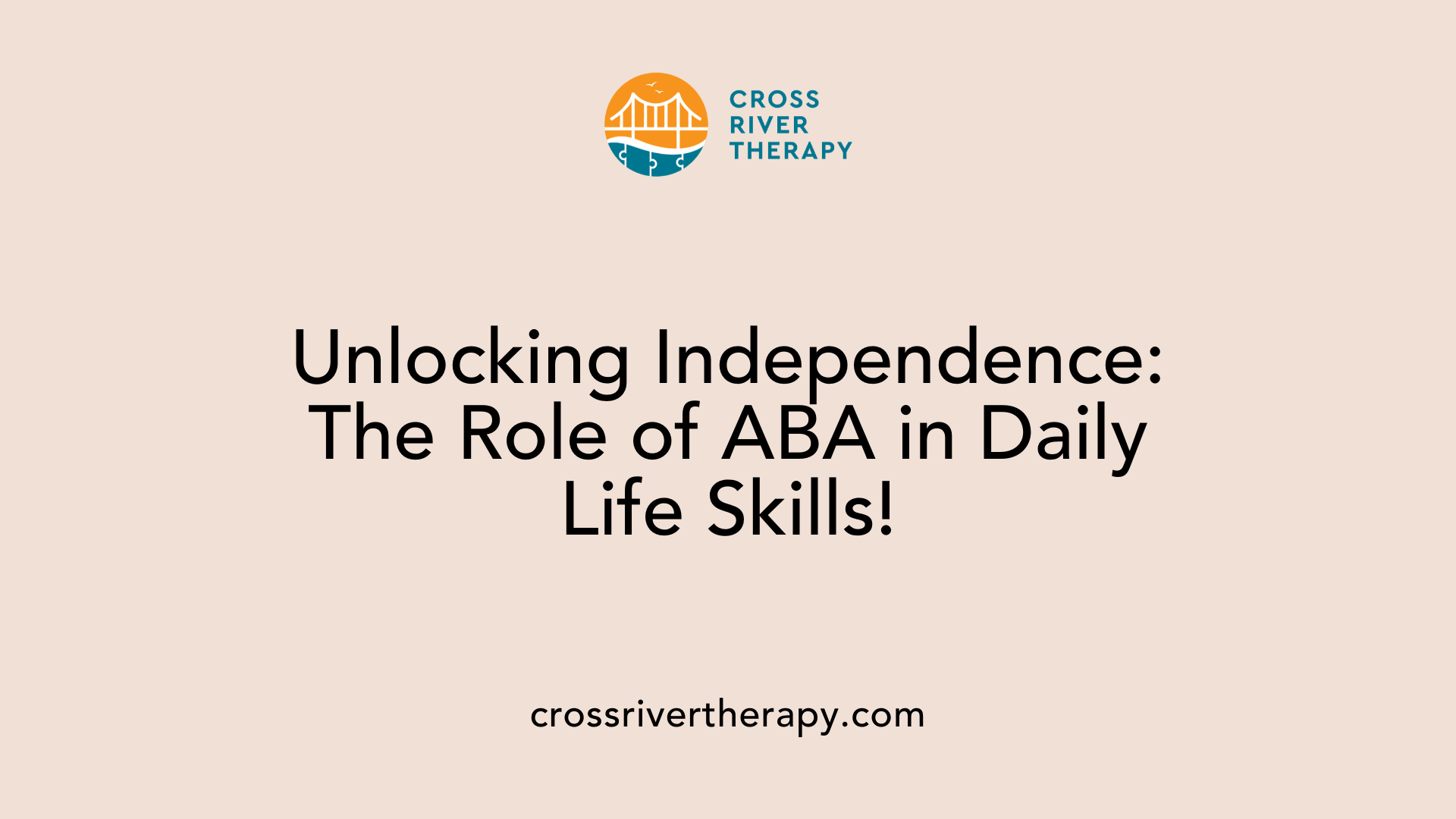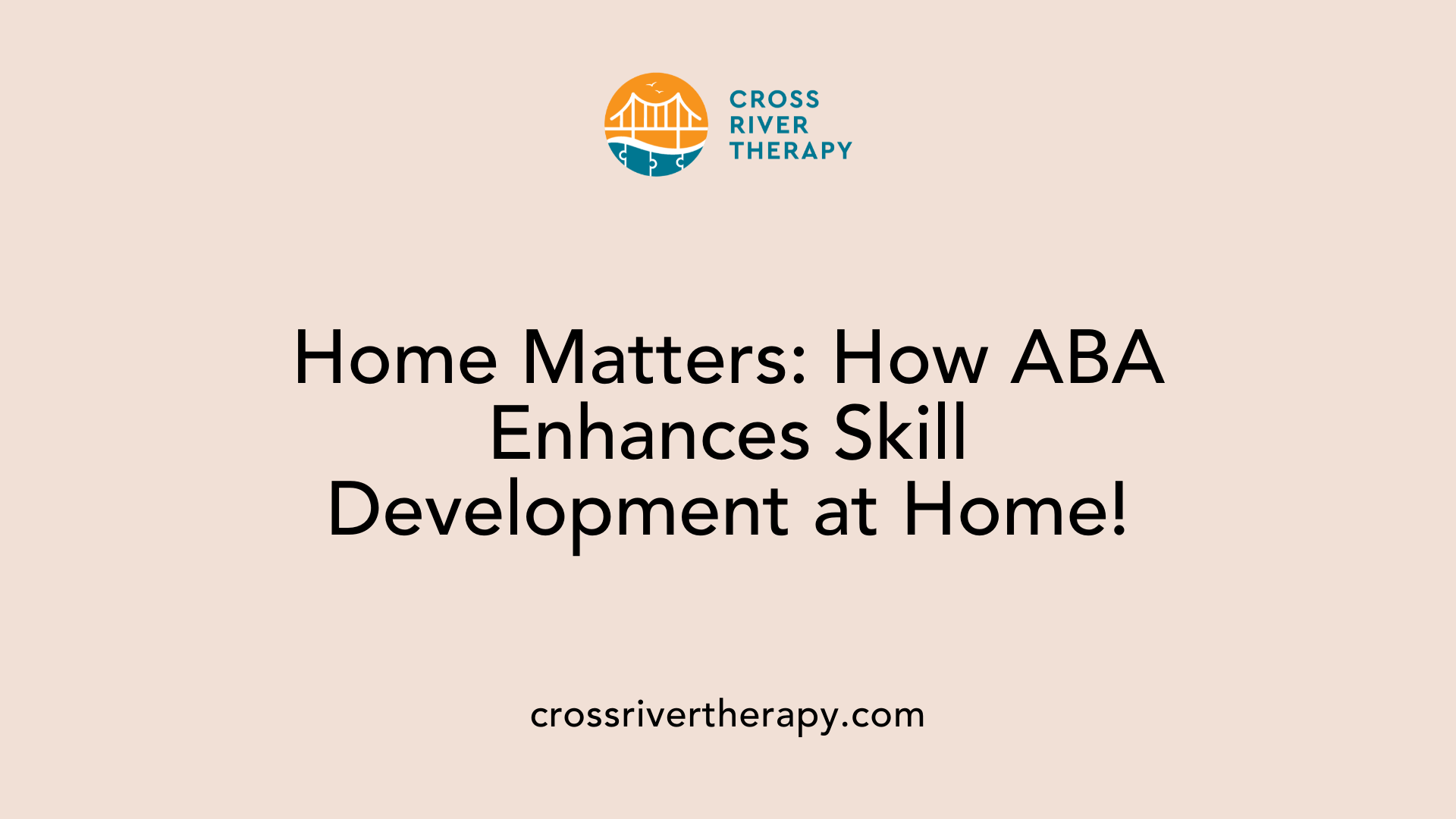How ABA Therapy at Home Enhances Daily Life Skills
Transforming Lives: The Impact of Home-Based ABA Therapy
Introduction: Enhancing Lives, One Skill at a Time
Applied Behavior Analysis (ABA) therapy is a well-researched method proven to aid individuals with autism and developmental challenges. This article explores how implementing ABA strategies at home not only enhances essential life skills but also strengthens family dynamics, contributing to overall quality of life improvements.
Key Benefits of ABA Therapy for Daily Life Skills

What are the benefits of ABA therapy for individuals with autism in improving daily life skills?
ABA therapy offers numerous benefits for individuals with autism in enhancing essential daily life skills. By utilizing structured methods that break tasks into manageable steps, individuals learn critical skills, such as brushing their teeth, grooming, and dressing, ultimately fostering greater independence. The emphasis on positive reinforcement strengthens learning endeavors, as desirable behaviors are encouraged through verbal praise and rewards.
Moreover, ABA therapy significantly improves communication skills. Using techniques like discrete trial training (DTT) and natural language teaching (NLT), individuals enhance their ability to express needs and engage in social interactions. This improved socialization is crucial in building relationships with peers and adults, further emphasizing the therapy's role in teaching effective communication alongside social skills through role-playing and modeling.
In addition to self-care and communication, ABA focuses on daily living skills like meal preparation, budgeting, and transportation. Structured plans support individuals in mastering these skills within natural environments, ensuring the relevance of learning.
Overall, the benefits include not only the acquisition of practical life skills but also the promotion of higher self-esteem and satisfaction, positively impacting the quality of life for individuals with autism and their families.
Integrating ABA Therapy at Home for Skill Development

How does home-based ABA therapy support skill development in areas like self-care, communication, and problem-solving?
Home-based ABA therapy is a vital tool for supporting skill development in areas such as self-care, communication, and problem-solving. By embedding learning within the child’s daily routines and natural environments, the therapy enhances the relevance and practical application of the skills being taught. This method encourages active participation from family members, allowing parents and siblings to reinforce therapeutic strategies and promote consistency in the child’s experiences.
Support for Daily Living Skills
Therapy sessions often focus on meaningful routines, such as brushing teeth or mealtimes, enabling children to practice these essential self-care skills within familiar contexts. For instance, caregivers can seamlessly incorporate visual aids and prompts during everyday activities, making it easier for children to learn and retain self-care techniques. This hands-on approach not only boosts the child’s independence but also alleviates anxiety associated with new skill acquisition.
Strengthening Communication Skills
In addition to self-care, home-based ABA therapy emphasizes effective communication through tailored, one-on-one interactions. Techniques like discrete trial training promote practice in expressing needs and thoughts, which can occur during family discussions at the dinner table. These settings reinforce verbal and non-verbal communication skills in a comfortable atmosphere.
Enhancing Problem-Solving Abilities
Moreover, therapy can address problem-solving skills by simulating scenarios within the home, allowing children to tackle challenges in real-time. With strategies grounded in practice, individuals learn to navigate daily life obstacles more effectively, fostering their confidence. Through close collaboration with therapists, families can adapt methods to fit their unique dynamics, ensuring that each child's specific needs and strengths are taken into account.
By fostering such an inclusive environment, home-based ABA therapy not only aids skill development but also strengthens family bonds, enhancing the overall quality of life for both the child and their family.
Promoting Independence and Social Skills Through ABA
What insights are there into how ABA therapy enhances independence and social interactions for children with developmental challenges?
ABA therapy plays a crucial role in enhancing independence and social interactions for children with developmental challenges. By focusing on a range of vital life skills, the therapy empowers children to develop essential self-care practices such as grooming, dressing, and meal preparation. These skills are taught using structured plans that break tasks into manageable steps, making the learning process more approachable.
Moreover, the therapy improves communication capabilities, both verbal and non-verbal. Techniques like discrete trial training and natural language teaching help kids articulate their needs and engage effectively with others. This fosters better relationships and minimizes frustrations that may arise from misunderstandings.
Positive reinforcement is a core element of ABA therapy. It not only encourages desired behaviors but also builds confidence. Verbal praise and rewards serve to motivate children as they navigate social interactions and daily tasks, enabling them to adapt more effectively in real-world scenarios.
The structured approach used in ABA therapy allows each child to progress at their own pace, ensuring that interventions are tailored to meet their individual needs and strengths. Programs, like Jumpstarting to Independence, underscore the critical impact of early intervention in achieving successful outcomes in both life skills and social engagement. Therefore, through ABA therapy, children gain valuable skills essential for independence and social connectivity within their communities.
Methodologies of ABA Therapy at Home
What are the methodologies and advantages of ABA therapy in a home setting?
Applied Behavior Analysis (ABA) therapy conducted in a home environment emphasizes enhancing beneficial behaviors while reducing detrimental ones. This approach employs various methodologies designed to meet individual needs effectively.
Discrete Trial Training (DTT) is a structured teaching technique utilized in ABA therapy. It breaks tasks into simple, manageable steps, reinforcing each step with positive feedback. This method allows individuals to learn at their own pace and build confidence over time.
Functional Communication Training (FCT) focuses on developing communication skills, allowing individuals to express their needs and thoughts effectively. This can be especially beneficial for children with autism, helping them articulate desires and reduce frustration associated with communication barriers.
Advantages of Home-Based ABA Therapy
One of the significant benefits of the home setting is the comfort it provides. Familiar surroundings can enhance engagement, making it easier for individuals to apply skills learned in therapy, promoting quicker and more meaningful progress.
Family involvement is essential in this model, as therapists work closely with families to create personalized treatment plans. This collaboration ensures consistency in practice and helps generalize skills across various daily settings, such as during meal prep or playtime.
Additionally, regular progress monitoring allows for continuous adjustments to the therapy, ensuring it remains effective and tailored to the evolving needs of the individual. Home-based ABA therapy fosters an inclusive atmosphere, enhancing familial bonds while promoting independence and self-esteem.
| Methodology | Description | Benefits |
|---|---|---|
| Discrete Trial Training (DTT) | Breaking tasks into manageable steps | Builds confidence and learning efficiency |
| Functional Communication Training (FCT) | Teaching effective communication | Reduces frustration, enhances expression |
| Family Involvement | Collaborative personalized plans | Ensures consistency, promotes generalization |
In summary, home-based ABA therapy offers a comprehensive approach tailored to individual needs, fostering skill acquisition in familiar environments.
Enhancing Family Dynamics Through ABA Therapy
How does ABA therapy impact family dynamics and the overall quality of life?
ABA therapy plays a vital role in reshaping family dynamics and elevating the overall quality of life for both children with autism and their families. By teaching essential life skills and promoting positive behaviors, ABA equips parents with the tools they need to support their children effectively. This individualized approach to therapy helps parents understand their child's unique needs, enabling them to reinforce constructive behaviors consistently.
Families benefit from improved communication and social interaction skills in their children, which leads to positive progress in family relationships. For instance, through structured interventions, children learn self-care skills, such as brushing their teeth and managing personal finances, which can significantly reduce parental stress during daily routines.
In addition to enhancing social skills, ABA therapy assists in reducing challenging behaviors that may disrupt family life. Behavior analysts work hand-in-hand with families to create a more harmonious home environment. Parents are empowered through education and ongoing support, which allows them to manage daily challenges with greater ease.
Moreover, by instilling valuable routines and fostering children’s independence, ABA therapy encourages healthier family interactions, leading to a more connected and supportive family unit. In essence, the ripple effect of ABA therapy creates a foundation for familial bonds that thrive on understanding, patience, and love.
Building Essential Self-Care Skills with ABA
Task Breakdown
ABA therapy is particularly effective in teaching essential self-care skills by breaking down tasks into manageable steps. For instance, when learning to brush teeth, the therapist might divide the process into specific actions: picking up the toothbrush, applying toothpaste, and brushing for the recommended time.
This structured approach helps individuals grasp each component of a routine, making it easier to learn and remember.
Positive Reinforcement
Positive reinforcement is a core element of ABA therapy, encouraging individuals to adopt self-care practices confidently. Therapists often use verbal praise, stickers, or small rewards when the individual successfully completes a self-care task, reinforcing the behavior.
This method not only rewards the accomplishment of the task but also boosts self-esteem and motivation to try again.
Safety and Hygiene Practices
In addition to self-care, ABA therapy emphasizes teaching safety and hygiene practices. Practicing handwashing techniques, understanding the importance of grooming, and following routines for dressing properly helps individuals develop crucial habits for personal care.
Such training not only promotes independence but also fosters a sense of responsibility towards one's well-being, laying the groundwork for a healthier lifestyle.
Facilitating Communication Growth with ABA

How Does ABA Therapy Enhance Communication Skills?
ABA therapy is a powerful approach for developing both verbal and non-verbal communication skills in individuals, particularly those with autism. By utilizing structured techniques, ABA creates effective pathways for expression and interaction.
What Techniques Are Used to Improve Communication?
Two predominant techniques in ABA therapy are Discrete Trial Training (DTT) and Natural Language Teaching (NLT):
- Discrete Trial Training (DTT): This method breaks down communication into specific, teachable segments. By focusing on small tasks, therapists can reinforce progress through repetition and rewards.
- Natural Language Teaching (NLT): NLT encourages communication in more natural settings, promoting spontaneous speech and social exchanges. Here, the emphasis is on using everyday situations to practice language skills.
Why Is Communication Development Important?
Promoting effective communication enables individuals to express their needs, thoughts, and emotions clearly, contributing significantly to their independence and quality of life. Consistent positive reinforcement during therapy supports the acquisition of new skills, enhancing vocabulary and social interactions over time.
Key Takeaway
By integrating these techniques into customized ABA programs, individuals can make significant strides in their communication abilities, fostering better relationships and social integration.
Developing Social Skills Through ABA Techniques

Role-Playing
Role-playing is a fundamental technique in ABA therapy that engages individuals in simulated social interactions. It allows participants to practice conversational exchanges and appropriate responses in a safe environment. By taking on different roles, they can learn to navigate various social situations effectively.
Social Stories
Social stories are another valuable tool used in ABA therapy. These narratives provide a framework for understanding social norms and expectations. Each story outlines specific scenarios, offering guidance on how to behave, respond, and interact in social settings. This method enhances comprehension and prepares individuals for real-life interactions.
Interaction Modeling
Modeling is a technique that demonstrates appropriate social behavior. Therapists model interactions for clients, showcasing how to initiate conversations and maintain dialogues. This visual representation helps individuals understand social cues, empowering them to apply these skills in their daily lives.
Incorporating these techniques fosters better communication and helps individuals establish rewarding relationships, ultimately enhancing their overall social engagement.
Organizational Skills: The Foundation of Autonomy
Planning and Prioritizing
ABA therapy plays a pivotal role in teaching individuals how to plan and prioritize their tasks. By breaking down larger goals into smaller, manageable tasks, individuals learn how to approach their daily activities effectively. This methodology fosters independence as learners start to understand the importance of sequencing their responsibilities based on urgency and significance.
Time Management
Effective time management techniques are also integrated into ABA therapy. Individuals are guided to create schedules, which help them allocate specific time slots for each task. By doing this, they not only learn to meet deadlines but also eliminate feelings of overwhelm associated with time constraints.
Use of Visual Aids
Visual aids are essential tools in ABA therapy that enhance organizational skills. Visual schedules, charts, and checklists provide clear instructions, supporting individuals in understanding their tasks at a glance. These aids simplify complex instructions and help maintain focus, significantly improving task completion rates.
Through these strategic approaches, ABA therapy successfully equips individuals with vital organizational skills that are crucial for greater autonomy in everyday life.
Problem Solving Skills for Real-World Challenges
Practice Scenarios for Real-World Applications
ABA therapy incorporates practice scenarios to help individuals develop problem-solving skills. These scenarios simulate real-life situations, allowing learners to engage in decision-making exercises relevant to their daily lives. For example, a child may practice selecting a clothing outfit for a specific occasion or deciding how to organize their homework tasks.
Strategic Thinking to Overcome Challenges
In addition to role-playing, ABA therapy promotes strategic thinking. Therapists teach individuals to analyze problems by breaking them down into manageable parts. This structured approach encourages learners to evaluate possible solutions and weigh their outcomes, fostering a proactive mindset capable of tackling various challenges.
Reinforcement of Successful Strategies
To enhance retention and build confidence, successful strategies are reinforced through positive feedback. When an individual successfully navigates a problem, they receive praise or rewards, solidifying their learning. This not only boosts their motivation but also encourages ongoing application of these skills in everyday scenarios, contributing to greater independence.
Extending ABA Benefits Beyond the Individual
Generalization into Broader Settings
ABA therapy encourages the generalization of learned skills beyond therapy sessions. Skills such as self-care, social interaction, and daily living can be practiced in various environments—home, school, and community settings. This method enhances the relevance and applicability of skills acquired during therapy.
Community Participation
Active community participation is crucial for individuals undergoing ABA therapy. By integrating skills learned in therapy into community activities, such as volunteering or engaging in local events, individuals can improve their social interactions and build relationships while gaining confidence.
Inclusive Learning Environments
Creating inclusive learning environments is vital for enhancing the experience of individuals with autism. ABA therapy can be applied in schools, ensuring customized educational plans that promote engagement and participation. This integration fosters understanding among peers and supportive relationships.
| Aspect | Description | Importance |
|---|---|---|
| Skill Generalization | Practical application of skills in different settings | Increases real-life relevance |
| Community Involvement | Participation in social events | Builds confidence and social networks |
| Inclusive Practices | Tailored ABA applications in educational settings | Enhances collaboration and empathy |
Adapting ABA Programs for Long-Term Success

Board-Certified Behavior Analysts
ABA therapy is designed and directed by Board-Certified Behavior Analysts (BCBAs), who play a crucial role in customizing interventions to meet the unique needs of each child. They assess individual strengths and challenges, ensuring that the therapy aligns with the child’s abilities and contexts. This tailored approach promotes meaningful skill development and enhances outcomes.
Progress Monitoring
Continuous progress monitoring is essential in ABA therapy. Therapists collect data on the child's performance regularly, allowing for the adjustment of interventions as needed. This data-driven method supports ongoing growth, ensuring that the therapy remains effective and aligned with the child’s evolving needs. It also highlights accomplishments and milestones, strengthening family support.
Tailoring Interventions
Interventions in ABA therapy are not one-size-fits-all; they require careful tailoring to reflect the child's learning pace and style. By considering variables such as developmental levels and personal interests, BCBAs create flexible plans that can adapt over time. This adaptability enhances the prospect of long-term success, enabling children to achieve greater independence and self-sufficiency.
Early Intervention and Lifelong Outcomes in ABA Therapy
Language Development
Early intervention in ABA therapy plays a pivotal role in enhancing language skills for individuals with autism. Techniques such as discrete trial training (DTT) focus on vocabulary expansion and social interaction. Children exposed to ABA at an early age often show significant improvements in communication, resulting in better expression of needs and desires.
Skill Acquisition
ABA therapy promotes the acquisition of crucial daily living skills. From self-care activities like grooming and dressing to more complex tasks like meal preparation, structured instruction with positive reinforcement helps individuals gain independence. Assessing abilities and practicing in real environments ensures the transfer of skills to daily life.
Independence Promotion
Fostering independence is a primary goal of ABA therapy. By teaching essential living skills, organizational techniques, and problem-solving strategies, individuals learn to navigate their environment effectively. Customized programs designed by Board-Certified Behavior Analysts (BCBA) ensure that interventions are relevant and tailored to each child, leading to greater confidence and self-reliance.
Conclusion: Empowering Futures with ABA
ABA therapy at home empowers individuals with autism by tailoring interventions to meet their unique needs within a familiar and supportive environment. This personalized approach not only fosters essential life skills and greater independence but also enhances family dynamics and quality of life. By celebrating each milestone, this therapy paves the way for lifelong success, ensuring individuals can lead enriched and fulfilling lives.
References
- 10 Ways ABA Therapy Can Help with Life Skills
- Teaching Kids Life Skills with ABA Therapy - ABATherapistJobs.com
- Enhance Family Life with ABA Therapy Services
- Life skills for autism | Autism Speaks
- Independence in Individuals with Autism: Role of ABA Therapy
- Benefits of ABA Therapy for Children with Autism
- How ABA Therapy Can Support Your Child's Development
- A creative solution to improve equity in Applied Behavior Analysis ...



